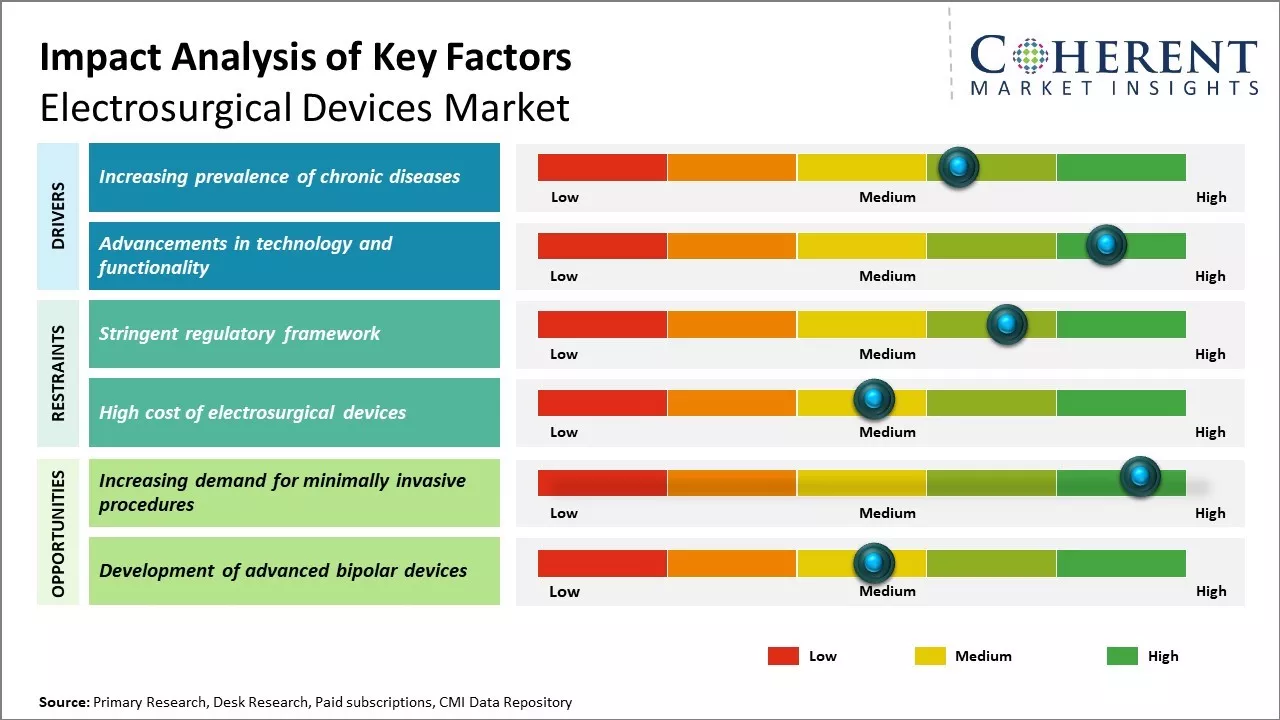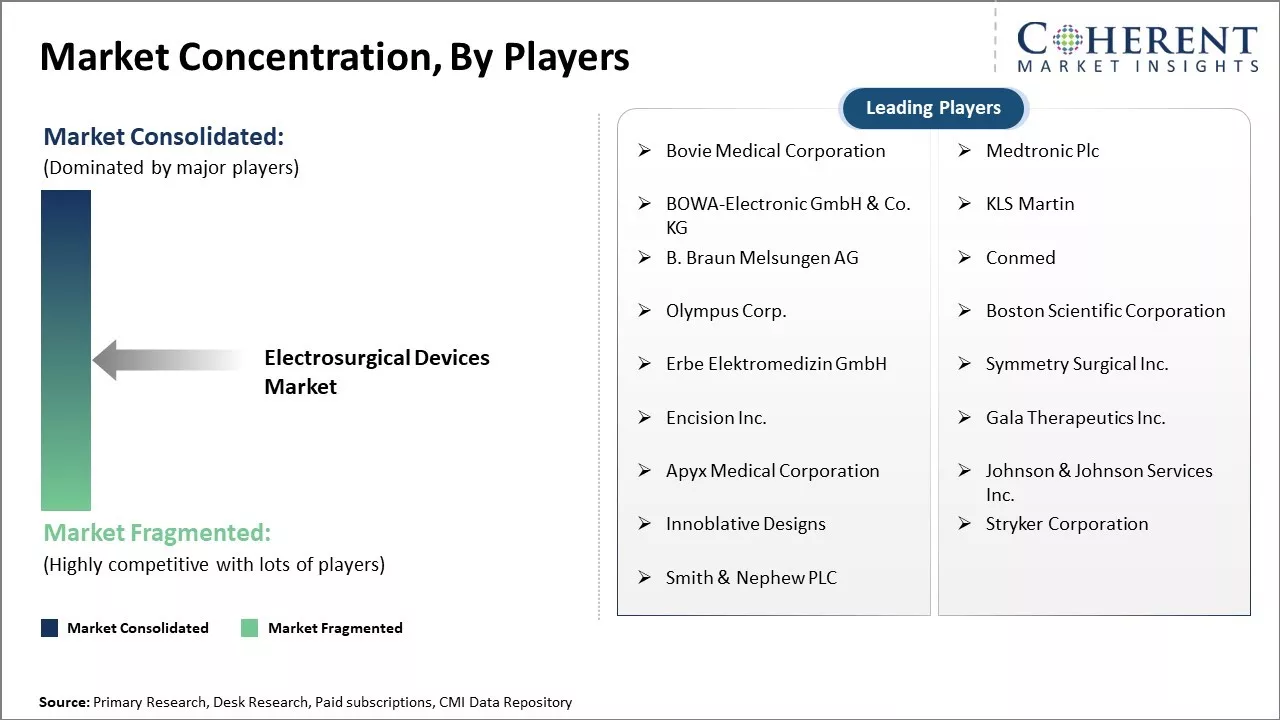The electrosurgical devices market is estimated to be valued at USD 7.01 Bn in 2025 and is expected to reach USD 10.90 Bn by 2032, growing at a compound annual growth rate (CAGR) of 6.5% from 2025 to 2032.

To learn more about this report, Download Free Sample
The global electrosurgical devices market is experiencing steady growth, driven by increasing demand for minimally invasive surgeries and advancements in surgical technologies. Electrosurgical tools offer precision, reduced blood loss, and faster recovery, making them essential in general surgery, neurology, and gynecology. Hospitals remain the primary end users due to high surgical volumes. North America dominates the market, supported by advanced healthcare infrastructure and major medical device manufacturers, while Asia Pacific shows strong growth potential with expanding healthcare access and rising surgical procedures.
|
Current Event |
Description and its impact |
|
Rising Surgical Volumes |
|
|
Healthcare Infrastructure Expansion in Emerging Markets |
|
|
Stricter Regulatory Oversight on Surgical Equipment |
|
Uncover macros and micros vetted on 75+ parameters: Get instant access to report
The electrosurgical devices market is witnessing an active innovation pipeline, driven by technological advancements and growing demand for minimally invasive procedures. Leading manufacturers such as Medtronic, Olympus Corporation, and Johnson & Johnson are investing heavily in R&D to develop next-generation electrosurgical tools with improved precision, safety, and energy efficiency.
Key innovations in the pipeline include AI-integrated electrosurgical generators, advanced bipolar and ultrasonic instruments, and smart energy delivery systems capable of real-time feedback and adaptive power control. Several products are in clinical trial phases, targeting applications in neurosurgery, oncology, and robotic-assisted surgery. Startups and mid-tier companies are also contributing with niche innovations, such as disposable electrodes and hybrid energy devices.
Regulatory approvals in major markets like the U.S. and EU are anticipated to accelerate commercialization. This dynamic pipeline reflects the industry's shift toward smarter, more versatile surgical solutions, ensuring robust future growth for the global electrosurgical devices market.
The electrosurgical devices market has a dynamic and evolving patent landscape, reflecting continuous innovation in energy-based surgical technologies. Major industry players such as Medtronic, Ethicon (Johnson & Johnson), Olympus Corporation, and CONMED are leading in patent filings, focusing on advancements in energy delivery, safety features, and minimally invasive applications.
Patents are increasingly cantered on integrated feedback systems, intelligent generators, and hybrid technologies combining ultrasonic and radiofrequency energy. Additionally, innovations in electrode design, thermal control mechanisms, and disposable components are gaining traction. The U.S., Europe, China, and Japan remain the top jurisdictions for filings, with a growing number of patents also emerging from India and South Korea.
Startups and academic institutions are contributing to the IP pool, particularly in AI-enabled surgical systems and robotic-assisted electro surgery. This competitive patent environment highlights strong barriers to entry and underlines the importance of intellectual property as a strategic asset in driving technological leadership and market growth.
The reimbursement landscape for electrosurgical devices is evolving, significantly influencing market adoption and growth. In developed regions like North America and Europe, favourable reimbursement policies for minimally invasive surgeries have accelerated the integration of advanced electrosurgical systems in hospitals and outpatient centres. These policies support the adoption of high-frequency electrosurgery devices, enhancing procedural efficiency and patient outcomes.
In emerging markets such as India, the reimbursement framework is still developing. While the Indian medical devices sector is experiencing substantial growth, challenges persist due to limited insurance coverage and out-of-pocket payment model. This scenario often restricts access to advanced electrosurgical technologies, particularly in public healthcare settings. Overall, the reimbursement environment remains a critical factor in the adoption of electrosurgical devices.
Regions with supportive reimbursement structures are witnessing higher uptake of these technologies, while areas with less developed frameworks may experience slower integration. As healthcare systems worldwide continue to evolve, aligning reimbursement policies with technological advancements will be essential to ensure broader access and sustained market growth.
Prescribers, including surgeons and medical practitioners, increasingly favour electrosurgical devices due to their precision, efficiency, and ability to minimize blood loss during procedures. These devices are particularly preferred in minimally invasive surgeries across specialties such as gynecology, neurology, urology, and gastroenterology. Surgeons value electrosurgical generators for their ability to offer real-time power adjustments and advanced safety features, which help reduce thermal damage to surrounding tissues.
Monopolar and bipolar electrosurgical systems are widely used, but there is a growing shift toward advanced bipolar and vessel-sealing technologies that enhance surgical outcomes. Moreover, device compatibility with robotic and laparoscopic systems influences prescribers’ choices, as integration with such platforms improves procedural control and patient recovery time.
Ease of use, device reliability, and manufacturer support also play a crucial role in prescriber preferences. Ultimately, clinical efficacy, safety profiles, and training availability significantly guide the decision-making process when adopting electrosurgical technologies in routine practice.

To learn more about this report, Download Free Sample
With the rising prevalence of chronic diseases globally, the number of surgical procedures has significantly increased over the past couple of decades. Chronic conditions such as cancer, cardiovascular diseases, and neurological disorders are some of the major public health issues contributing to the growing disease burden. According to the World Health Organization (WHO), cancer is the second leading cause of deaths worldwide with nearly 10 million deaths in 2020.
Rising geriatric population is another key factor influencing the cancer statistics as older adults are more prone to develop cancer. Similarly, heart diseases also pose a huge economic and health burden on economies. Improved diagnostic capabilities and lifestyle changes have led to a surge in the number of open-heart surgeries and other cardiac procedures performed annually.
In June 2013, doctors at Sterling Hospital in Ahmedabad successfully removed 44 cancerous nodules from a patient's lung using an electrosurgical device. The procedure involved the use of an electrosurgical tool that cuts and coagulates tissue, allowing for the removal of multiple nodules without causing significant damage to the surrounding healthy lung tissue. This case demonstrated the precision and effectiveness of electrosurgical techniques in complex oncological surgeries.
Over the past few decades, remarkable innovations have been witnessed in electrosurgical technologies aimed at making procedures safer, minimally-invasive, and more effective. Gradually moving from traditional monopolar and bipolar devices, advanced energy platforms such as Argon plasma coagulation, ultrasound, and vessel sealing systems are gaining momentum.
These new age devices provide enhanced visibility, precision cutting, and hemostasis with reduced risk of collateral tissue damage. Manufacturers are constantly striving to develop intelligent systems with advanced bipolar and monopolar modes, automatic control of energy delivery and improved ergonomics. The integration of robotics, 3D imaging, tissue analytics, and newer energy modalities in electrosurgery intends for maximizing clinical outcomes.
In January 2012, medical experts in Pune discussed alternatives to traditional hysterectomy procedures, highlighting the use of electrosurgical techniques like the Loop Electrosurgical Excision Procedure (LEEP) for treating precancerous lesions of the cervix. These minimally invasive procedures offer patients options that are less invasive than full hysterectomy, leading to quicker recovery times and preservation of reproductive health.
The rapidly aging global population susceptible to various medical conditions will drive surgical volumes. Moreover, the demand for minimally invasive procedures is growing with advancing technology. This is increasing the acceptance of electrosurgical equipment. There is also scope to expand in emerging markets as their healthcare infrastructure and accessibility improves.
Adoption of distribution partnerships and strategic mergers by key market players is further anticipated to create lucrative opportunities for market development over the projected period.
The electrosurgical generators segment is projected to dominate the global electrosurgical devices market, accounting for 32.3% of the total share in 2025. This dominance can be attributed to continuous product innovation, enhanced safety features, and improved energy delivery mechanisms.
Electrosurgical generators are essential in a wide range of surgical procedures due to their ability to control heat and minimize tissue damage, which is particularly crucial in minimally invasive surgeries. Advancements in smart generators that offer real-time feedback, automated power adjustments, and compatibility with various electrode types further reinforce their market leadership.
The neurology application segment is expected to hold a 26.1% share of the electrosurgical devices market in 2025, emerging as the leading contributor. This growth is primarily driven by the increasing prevalence of neurological disorders and the growing demand for precision-based surgical interventions.
Electrosurgical tools play a critical role in delicate neurosurgical procedures, offering enhanced precision, reduced bleeding, and minimized recovery time. The rising geriatric population, along with technological advancements in neuro-electrosurgical techniques, continues to accelerate demand in this segment.
Hospitals are projected to account for the largest share of the electrosurgical devices market at 40.1% in 2025. The high patient volume, availability of advanced infrastructure, and increased adoption of minimally invasive surgical equipment are key factors supporting this dominance.
Hospitals also benefit from the presence of skilled professionals and access to comprehensive post-surgical care, making them the preferred setting for complex electrosurgical procedures. Additionally, favourable reimbursement policies and increased healthcare investments are expected to further solidify the role of hospitals as the leading end user.

To learn more about this report, Download Free Sample
North America is projected to maintain its dominance in the global electrosurgical devices market with a 43.4% share in 2025. This regional leadership is primarily fuelled by robust healthcare infrastructure, early adoption of advanced surgical technologies, and the presence of major medical device manufacturers.
The United States, in particular, has witnessed a surge in minimally invasive surgeries, increasing the demand for electrosurgical equipment. Moreover, strong regulatory support, high healthcare spending, and a growing elderly population with chronic conditions further reinforce North America's leading position in the market.
Europe is expected to remain a significant contributor to the electrosurgical devices market, driven by an aging population, rising prevalence of chronic diseases, and a focus on improving surgical outcomes. Countries such as Germany, France, and the UK are experiencing increasing demand for advanced surgical tools that enhance precision and minimize patient recovery time.
Stringent medical device regulations and consistent investments in healthcare infrastructure support the adoption of high-performance electrosurgical systems. Additionally, government-led initiatives to reduce surgical complications and enhance patient safety further boost market growth in the region.
The United States and Canada lead the electrosurgical devices market in North America, which is expected to maintain a 43.4% global share in 2025. The U.S. dominates with its advanced healthcare infrastructure, high volume of surgical procedures, and strong presence of key medical device manufacturers. Widespread adoption of minimally invasive and robotic-assisted surgeries continues to drive demand.
Canada complements this leadership through growing investment in surgical innovations, favorable government healthcare policies, and increasing demand for safe and efficient surgical technologies.
| Report Coverage | Details | ||
|---|---|---|---|
| Base Year: | 2024 | Market Size in 2025: | USD 7.01 Bn |
| Historical Data for: | 2020 To 2024 | Forecast Period: | 2025 To 2032 |
| Forecast Period 2025 to 2032 CAGR: | 6.5% | 2032 Value Projection: | USD 10.90 Bn |
| Geographies covered: |
|
||
| Segments covered: |
|
||
| Companies covered: |
Bovie Medical Corporation, Medtronic Plc, BOWA-Electronic GmbH & Co. KG, KLS Martin, B. Braun Melsungen AG, Conmed, Olympus Corp., Boston Scientific Corporation, Erbe Elektromedizin GmbH, Symmetry Surgical Inc., Encision Inc., Gala Therapeutics Inc., Apyx Medical Corporation, Johnson & Johnson Services Inc., Innoblative Designs, Stryker Corporation, and Smith & Nephew PLC |
||
| Growth Drivers: |
|
||
| Restraints & Challenges: |
|
||
Uncover macros and micros vetted on 75+ parameters: Get instant access to report
Share
Share
About Author
Manisha Vibhute is a consultant with over 5 years of experience in market research and consulting. With a strong understanding of market dynamics, Manisha assists clients in developing effective market access strategies. She helps medical device companies navigate pricing, reimbursement, and regulatory pathways to ensure successful product launches.
Missing comfort of reading report in your local language? Find your preferred language :
Transform your Strategy with Exclusive Trending Reports :
Frequently Asked Questions
Joining thousands of companies around the world committed to making the Excellent Business Solutions.
View All Our Clients